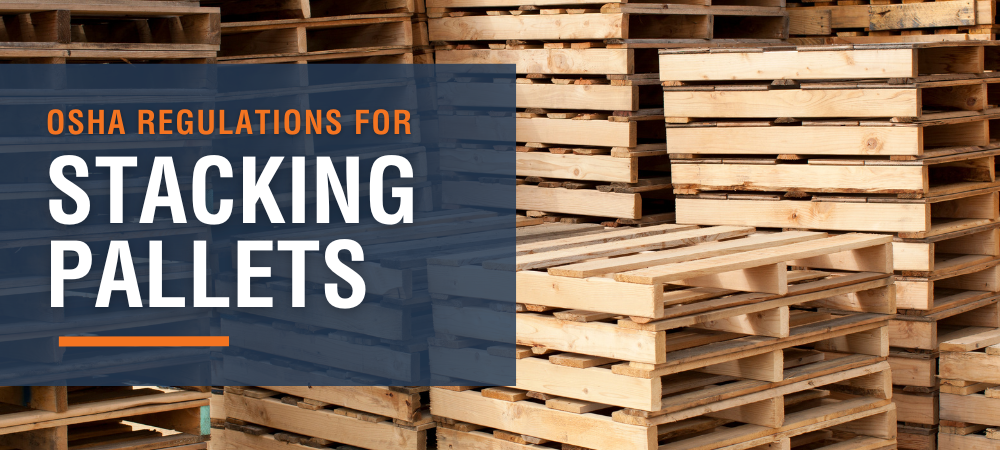We use cookies to make your experience better. To comply with the new e-Privacy directive, we need to ask for your consent to set the cookies. Learn more.
Stacking Pallets: OSHA Regulations

Stacking empty pallets saves space and removes tripping and collision hazards from warehouse floors. But if workers stack pallets carelessly or overly high, they could be creating an even bigger hazard. To figure out the best practices for pallet stacking, let's take a look at what OSHA and other regulators have to say.
OSHA addresses stacks of items, including pallets, in standard 1910.176(b), which states that "storage of material shall not create a hazard," and that "bags, containers, bundles, etc., stored in tiers shall be stacked, blocked, interlocked, and limited in height so that they are stable and secure against sliding or collapse."
That sounds reasonable. But the question now becomes, "How do you stabilize a stack of pallets?"
Stabilizing Pallet Stacks for Optimal Safety
Never mix sizes when stacking pallets. An odd-sized pallet near the bottom of the stack could compromise the stability of the entire load, and that's a dangerous proposition. Never stack pallets on their sides—this also creates instability.
Don't reuse damaged pallets. Splintered ends and protruding nails can cause serious injuries to workers. Pallets with missing pieces will eventually break and can cause loss of product or staff injuries in the process.
Stacking frames or racks can add a great deal of stability to a pallet stack. Just be sure never to overload them or allow employees to climb on them.
Here's a quick recap of pallet stacking best practices:
- Never stack mixed sizes of pallets.
- Never stack pallets on their sides.
- Use pallet stacking frames or stacking racks to stabilize the load.
- Don't reuse damaged pallets.
- Keep stacks at a safe height.
Of course, we still have to figure out what regulators mean by a "safe height."
How High Is Too High for Stacking Pallets?
There's no particular OSHA standard that tells you a stack of pallets can be this or that many feet tall. Instead, look at how close to the ceiling a stable stack is, and, more to the point, how close to the sprinkler system your pallets reach.
The standard in question here is 1910.159, which covers automatic sprinkler systems. More specifically, look to standard 1910.159(c)(10), which tells us that "the minimum vertical clearance between sprinklers and the material below shall be 18 inches."
The National Fire Protection Agency gives us a bit more detail on this restriction in NFPA 13: Standard for the Installation of Sprinkler Systems. This document largely echoes OSHA's 18-inch limit, but it also points out that some stacks that are further from the sprinklers may still be objectionable. It says that any obstruction that interrupts the full deployment pattern of a sprinkler's water stream presents a problem, and should be avoided (unless you want to install sprinklers beneath that obstruction, which makes no sense for a stack of pallets).
In short, the question isn't how high you can stack pallets, as long as those stacks are stable and safe. The question is how close to the sprinklers those stacks reach.
Create a Plan and Stick to It
Managers in every industry need a plan for empty pallets. In the construction field, OSHA standard 1926.25(a) reads, "During the course of construction, alteration, or repairs, form and scrap lumber with protruding nails, and all other debris, shall be kept cleared from work areas, passageways, and stairs, in and around buildings or other structures."
Leaving empty pallets where pedestrians walk and lift trucks drive creates a major safety hazard. Neatly stacking pallets using best practices solves this issue. This is as true for warehouses and other applications as it is for construction, and safe pallet stacking is crucial wherever pallets are found.
References:
"29 CFR 1910.159: Automatic sprinkler systems." OSHA.Occupational Safety and Health Administration, U.S. Department of Labor, n.d. Web. 6 May 2019.
"29 CFR 1910.176: Handling materials - general." OSHA. Occupational Safety and Health Administration, U.S. Department of Labor, n.d. Web. 6 May 2019.
"29 CFR 1926.25: Housekeeping." OSHA. Occupational Safety and Health Administration, U.S. Department of Labor, n.d. Web. 13 July 2017.
Kiley, Brian. "How Should I Store Idle Pallets?" TheSilverLining. West Bend Mutual Insurance Company, 20 June 2014. Web. 13 July 2017.
"NFPA 13: Standard for the Installation of Sprinkler Systems." NFPA. National Fire Protection Association, 2019. Web. 6 May 2019.
